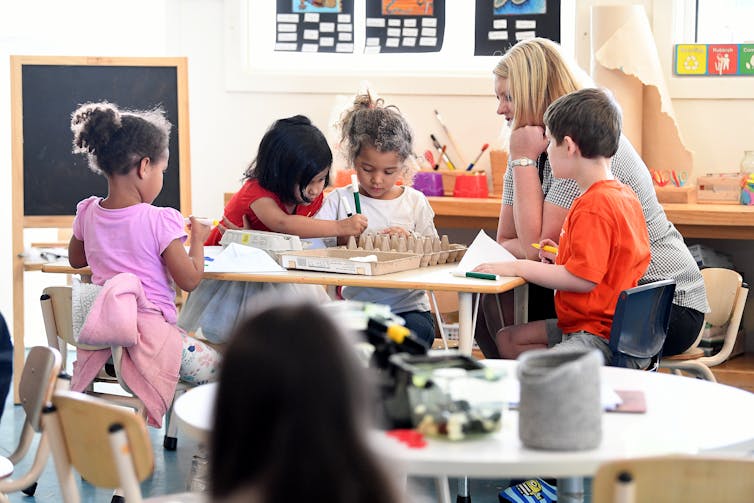Why everyone benefits from getting more three-year-olds into preschool
- Written by Alison Elliott, Professor of Education, CQUniversity Australia
On Thursday, the Labor party pledged an additional A$1.75 billion for early education if elected the next government of Australia. This is the largest investment in early childhood education in Australian history.
Most of this investment will go towards funding 15 hours a week of free preschool or kindy for three-year-old children. This means all Australian children will have access to two years of quality early childhood education before they start school.
Current funding only supports preschool programs for children the year before they start formal schooling. Typically, 15 hours a week equates to five short days per fortnight or two days a week of a preschool program in a school preschool, community kindy or long day care centre.
Early childhood educators, researchers and economists have long advocated the importance of early childhood education. If Labor does win the next election and commit to this promise, everyone will benefit. Two years of preschool will give young Australian children the best start in life.
What does the research say about development?
Neuroscience has shown the early years, particularly birth to eight years, are critical for optimal learning and development. Preschool attendance has shown consistent positive short and long-term effects across the world including in the US, Europe, Canada and New Zealand.
Play-based preschool programs delivered by qualified early childhood educators improve children’s learning and developmental outcomes and are particularly important for children from disadvantaged backgrounds.
A recent independent report to state and territory education ministers argued, in terms of improving school outcomes, the single most impactful reform Australia could make would be to increase access to quality early childhood education (preschool) for three-year-olds.
 Preschool education has positive effects on early language and literacy, and school achievement.
from www.shutterstock.com
Preschool education has positive effects on early language and literacy, and school achievement.
from www.shutterstock.com
Another report showed two years of preschool has more impact than one, especially for children who are developmentally vulnerable (such as those from a low socio-economic background).
Compared to other OECD countries, Australia is lagging behind in early childhood education. Australia ranked in the bottom third for participation in early childhood education and care. Only 15% of Australian three-year-olds are enrolled in a preschool program.
It also makes economic sense
Economists also back getting three-year-olds into preschool, as it’s a great opportunity for investment in human capital and the future workforce. It’s much more cost effective and beneficial to invest in early education than later remedial interventions targeted at poor literacy, school drop-outs and adults with limited basic skills. In early childhood, we set the foundation for learning dispositions and life skills.
Read more: Why Australia should invest in paying early childhood educators a liveable wage
Preschool education has positive effects on early language and literacy, and school achievement. A recent study showed two years of preschool had a cost benefit ratio of four, meaning for every one dollar invested, four dollars are returned to the economy.
What would these programs look like?
Universal access means younger children will have access to a four-year degree qualified teacher who provides a play-based program aligning with the Early Years Learning Framework. Play-based learning is where children learn through play, either self-directed (often called free play), or guided play where an adult intentionally extends children’s learning through play and related activities.
Read more: Play-based learning can set your child up for success at school and beyond
High quality preschool programs promote children’s academic and social development and provide a balance of intentional teaching and freely chosen play activities. Educators extend children’s learning by engaging in prolonged conversations where the educator and child solve problems together, clarify concepts or evaluate things that develop and extend thinking or understanding.
And what about these children and their parents?
Labor has promised the three-year-old preschool programs will be delivered through a range of early education settings. These include long day care centres, community preschools/kindies and schools. This is good news for parents who will be able to choose a program that suits their family’s needs and especially for children who currently attend child care. Embedding strong early learning programs with qualified teachers into child care means a more integrated and seamless learning experience for children.
 Providing three-year-olds with access to universal preschool makes good economic and social sense.
Dave Hunt/AAP
Providing three-year-olds with access to universal preschool makes good economic and social sense.
Dave Hunt/AAP
Three-year-old preschool programs will also help parents with childcare affordability. For parents with children already in care, 15 hours will be funded by the government, cutting costs to families.
The one caution in thinking about the logistics of providing 15 hours of preschool is around the current extreme shortage of early childhood teachers and other early childhood educators. As the 2015 Productivity Commission reported, supply of early childhood teachers does not meet demand. Unless there is a massive increase in training early childhood teachers the likelihood of staffing the new preschool places by 2021 is slim, especially in rural and remote Australia.
Today’s announcement of free training for early childhood education and care qualifications through the vocational education and training (VET) system should Labor be elected next year is welcome.
But caution is warranted as VET-credentialed educators (with certificates and diplomas) are not qualified early childhood teachers. Simply offering free training is a long way short of ensuring qualified educators are willing and able to actually work where they’re most needed.
And as the recent ASQA report highlighted, the quality of delivery of many VET courses in early childhood education and care is variable and often problematic.
No matter what your political or educational perspective, giving children the best start to early learning makes good sense. Investment in early childhood education can only benefit children, families and the nation.
Authors: Alison Elliott, Professor of Education, CQUniversity Australia



